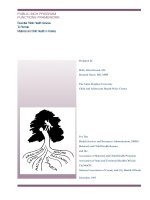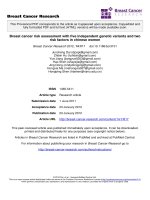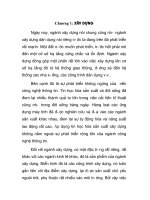HANDBOOK OFCHEMICAL RISK ASSESSMENT Health Hazards to Humans, Plants, and Animals ( VOLUME 1 ) - PART 1 ppsx
Bạn đang xem bản rút gọn của tài liệu. Xem và tải ngay bản đầy đủ của tài liệu tại đây (5.05 MB, 442 trang )
VOLUME 1
Metals
CHEMICAL RISK
ASSESSMENT
HANDBOOK OF
Health Hazards to Humans,
Plants, and Animals
© 2000 by CRC Press LLC
LEWIS PUBLISHERS
Boca Raton London New York Washington, D.C.
Ronald Eisler, Ph.D.
U.S. Geological Survey
Patuxent Wildlife Research Center
Laurel, Maryland
VOLUME 1
Metals
CHEMICAL RISK
ASSESSMENT
HANDBOOK OF
Health Hazards to Humans,
Plants, and Animals
VOLUME 2
Organics
CHEMICAL RISK
ASSESSMENT
HANDBOOK OF
Health Hazards to Humans,
Plants, and Animals
© 2000 by CRC Press LLC
LEWIS PUBLISHERS
Boca Raton London New York Washington, D.C.
Ronald Eisler, Ph.D.
U.S. Geological Survey
Patuxent Wildlife Research Center
Laurel, Maryland
VOLUME 2
Organics
CHEMICAL RISK
ASSESSMENT
HANDBOOK OF
Health Hazards to Humans,
Plants, and Animals
CHEMICAL RISK
ASSESSMENT
HANDBOOK OF
Health Hazards to Humans,
Plants, and Animals
VOLUME 3
Metalloids, Radiation,
Cumulative Index to
Chemicals and Species
© 2000 by CRC Press LLC
LEWIS PUBLISHERS
Boca Raton London New York Washington, D.C.
Ronald Eisler, Ph.D.
U.S. Geological Survey
Patuxent Wildlife Research Center
Laurel, Maryland
CHEMICAL RISK
ASSESSMENT
HANDBOOK OF
Health Hazards to Humans,
Plants, and Animals
VOLUME 3
Metalloids, Radiation,
Cumulative Index to
Chemicals and Species
This work is a reprint of a publication of the United States Government. Reasonable efforts have been made to publish
reliable data and information, however, neither the United States Government nor the publisher makes any warranty, express
or implied, or assumes any legal liability or responsibility for the accuracy, completeness, or usefulness of any information,
apparatus, product, or process disclosed, or represents that its use would not infringe privately owned rights. Reference
herein to any specific commercial products, process, or service by trade name, trademark, manufacturer, or otherwise does
not necessarily constitute or imply its endorsement, recommendation, or favoring by the United States Government or the
publisher. The views and opinions expressed herein do not necessarily state or reflect those of the United States Government
or the publisher and shall not be used for advertising or product endorsement purposes.
Permission to reproduce wholly or in part for purposes other than personal or research and teaching must be requested
in writing.
Direct all inquiries to CRC Press LLC, 2000 N. W. Corporate Blvd., Boca Raton, Florida 33431.
First CRC Press LLC Printing, 2000
Lewis Publishers is an imprint of CRC Press LLC
No claim to original U.S. Government works
International Standard Book Number 1-56670-505-3 (v. 3 of 3-v. set) 1-56670-506-1 (set)
Library of Congress Card Number 99-053394
Printed in the United States of America 1 2 3 4 5 6 7 8 9 0
Printed on acid-free paper
Library of Congress Cataloging-in-Publication Data
Eisler, Ronald, 1932–
Handbook of chemical risk assessment: health hazards to humans, plants, and animals / by Ronald Eisler
p. cm.
Includes bibliographical references and index.
Contents: v. 1. Metals — v. 2. Organics — v. 3. Metalloids, radiation, cumulative index to chemicals and species.
ISBN 1-56670-503-7 (v. 1: alk. paper) — ISBN 1-56670-504-5 (v. 2: alk. paper) — ISBN 1-56670-505-3
(v. 3: alk. paper) — ISBN 1-56670-506-1 (set: alk. paper)
1. Pollutants — Handbooks, manuals, etc. 2. Hazardous substances — Risk assessment — Handbooks, manuals,
etc. 3. Environmental chemistry — Handbooks, manuals, etc. 4. Environmental risk assessment — Handbooks,
manuals, etc. I. Title.
TD196.C45 E38 2000
363.17
′
9 — dc21 99-053394
CIP
© 2000 by CRC Press LLC
About the Author
Ronald Eisler
received his A.B. degree from New York
University in biology and chemistry, and M.S. and Ph.D. degrees
from the University of Washington in aquatic sciences and radio-
ecology, respectively. He attended the University of Miami
Marine Laboratory prior to military service. He is a member of
the American Chemical Society, the American Fisheries Society,
the Marine Biological Association of the United Kingdom, and
the Society for Environmental Geochemistry and Health. Since
1955 he has authored more than 125 technical articles and books
on contaminant hazards to living organisms.
From 1984 to the present, Dr. Eisler has been a senior
research biologist at the U.S. Geological Survey, Patuxent Wild-
life Research Center, located in Laurel, Maryland. Prior to 1984,
he held the following positions, in order: bioscience advisor,
U.S. Fish and Wildlife Service, Washington, D.C.; research
aquatic toxicologist, U.S. Environmental Protection Agency,
Narrangansett, Rhode Island; fishery research biologist, U.S. Fish and Wildlife Service, Highlands,
New Jersey; radiochemist, University of Washington Laboratory of Radiation Ecology, Seattle,
Washington; aquatic biologist, New York State Department of Environmental Conservation, Ray-
brook, New York; biochemist, U.S. Army Medical Nutrition Laboratory, Medical Service Corps,
Denver, Colorado.
He has held several adjunct professor appointments and was especially active at the Graduate
School of Oceanography, University of Rhode Island; the Department of Oceanography and Marine
Biology, Hebrew University of Jerusalem; and the Department of Biology, American University,
Washington, D.C.
Dr. Eisler is currently on the editorial board of
Marine Ecology Progress Series
and other
technical journals.
© 2000 by CRC Press LLC
© 2000 by CRC Press LLC
Contents
Chapter 1
Cadmium
1.1 Introduction
1.2 Environmental Chemistry
1.3 Concentrations in Field Collections
1.4 Lethal Effects
1.5 Sublethal Effects
1.6 Bioaccumulation
1.7 Teratogenesis, Mutagenesis, and Carcinogenesis
1.8 Recommendations
1.9 Summary
1.10 Literature Cited
Chapter 2
Chromium
2.1 Introduction
2.2 Environmental Chemistry
2.3 Concentrations in Field Collections
2.4 Beneficial and Protective Properties
2.5 Lethal Effects
2.5.1 General
2.5.2 Aquatic Organisms
2.5.3 Terrestrial Invertebrates
2.5.4 Mammals and Birds
2.6 Sublethal Effects
2.6.1 General
2.6.2 Aquatic Organisms: Freshwater
2.6.3 Aquatic Organisms: Marine
2.6.4 Birds
2.6.5 Mammals
2.7 Field Investigations
2.8 Recommendations
2.9 Summary
2.10 Literature Cited
Chapter 3
Copper
3.1 Introduction
3.2 Sources and Uses
3.2.1 General
3.2.2 Sources
3.2.3 Uses
3.3 Chemical and Biochemical Properties
3.3.1 General
3.3.2 Chemical Properties
3.3.3 Metabolism
3.3.4 Interactions
3.4 Carcinogenicity, Mutagenicity, and Teratogenicity
3.4.1 General
3.4.2 Carcinogenicity
© 2000 by CRC Press LLC
3.4.3 Mutagenicity
3.4.4 Teratogenicity
3.5 Concentrations in Field Collections
3.5.1 General
3.5.2 Abiotic Materials
3.5.3 Terrestrial Plants and Invertebrates
3.5.4 Aquatic Organisms
3.5.5 Amphibians and Reptiles
3.5.6 Birds
3.5.7 Mammals
3.6 Copper Deficiency Effects
3.6.1 General
3.6.2 Terrestrial Plants and Invertebrates
3.6.3 Aquatic Organisms
3.6.4 Birds and Mammals
3.7 Lethal and Sublethal Effects
3.7.1 General
3.7.2 Terrestrial Plants and Invertebrates
3.7.3 Aquatic Organisms
3.7.4 Birds
3.7.5 Mammals
3.8 Proposed Criteria and Recommendations
3.9 Summary
3.10 Literature Cited
Chapter 4
Lead
4.1 Introduction
4.2 Sources and Uses
4.3 Chemical Properties
4.4 Mode of Action
4.5 Concentrations in Field Collections
4.5.1 General
4.5.2 Nonbiological Samples
4.5.3 Fungi, Mosses, Lichens
4.5.4 Terrestrial Plants
4.5.5 Terrestrial Invertebrates
4.5.6 Aquatic Biota
4.5.7 Amphibians and Reptiles
4.5.8 Birds
4.5.9 Mammals
4.6 Lethal and Sublethal Effects
4.6.1 General
4.6.2 Terrestrial Plants and Invertebrates
4.6.3 Aquatic Biota
4.6.4 Amphibians and Reptiles
4.6.5 Birds
4.6.6 Mammals
4.7 Recommendations
4.8 Summary
4.9 Literature Cited
© 2000 by CRC Press LLC
Chapter 5
Mercury
5.1 Introduction
5.2 Sources of Environmental Mercury
5.3 Chemical and Biochemical Properties
5.4 Mercury in Minamata, Japan
5.5 Concentrations in Field Collections
5.5.1 General
5.5.2 Nonbiological
5.5.3 Biological
5.6 Lethal Effects
5.6.1 General
5.6.2 Aquatic Organisms
5.6.3 Birds
5.6.4 Mammals
5.6.5 Other Groups
5.7 Sublethal Effects
5.7.1 General
5.7.2 Carcinogenicity, Genotoxicity, and Teratogenicity
5.7.3 Aquatic Organisms
5.7.4 Birds
5.7.5 Mammals
5.7.6 Other Groups
5.8 Recommendations
5.9 Summary
5.10 Literature Cited
Chapter 6
Nickel
6.1 Introduction
6.2 Sources and Uses
6.2.1 General
6.2.2 Source
6.2.3 Uses
6.3 Chemical and Biological Properties
6.3.1 General
6.3.2 Physical and Chemical Properties
6.3.3 Metabolism
6.3.4 Interactions
6.4 Carcinogenicity, Mutagenicity, and Teratogenicity
6.4.1 General
6.4.2 Carcinogenicity
6.4.3 Mutagenicity
6.4.4 Teratogenicity
6.5 Concentrations in Field Collections
6.5.1 General
6.5.2 Abiotic Materials
6.5.3 Terrestrial Plants and Invertebrates
6.5.4 Aquatic Organisms
6.5.5 Amphibians
6.5.6 Birds
© 2000 by CRC Press LLC
6.5.7 Mammals
6.5.8 Integrated Studies
6.6 Nickel Deficiency Effects
6.6.1 General
6.6.2 Bacteria and Plants
6.6.3 Birds
6.6.4 Mammals
6.7 Lethal and Sublethal Effects
6.7.1 General
6.7.2 Terrestrial Plants and Invertebrates
6.7.3 Aquatic Organisms
6.7.4 Birds
6.7.5 Mammals
6.8 Proposed Criteria and Recommendations
6.9 Summary
6.10 Literature Cited
Chapter 7
Silver
7.1 Introduction
7.2 Sources and Uses
7.2.1 General
7.2.2 Sources
7.2.3 Uses
7.3 Chemistry and Metabolism
7.3.1 General
7.3.2 Physical and Chemical Properties
7.3.3 Metabolism
7.4 Concentrations in Field Collections
7.4.1 General
7.4.2 Nonbiological Materials
7.4.3 Plants and Animals
7.5 Lethal and Sublethal Effects
7.5.1 General
7.5.2 Terrestrial Plants
7.5.3 Aquatic Organisms
7.5.4 Birds and Mammals
7.6 Recommendations
7.7 Summary
7.8 Literature Cited
Chapter 8
Tin
8.1 Introduction
8.2 Chemical and Biochemical Properties
8.2.1 General
8.2.2 Inorganic Tin
8.2.3 Organotins
8.3 Sources and Uses
8.4 Concentrations in Field Collections
8.4.1 General
© 2000 by CRC Press LLC
8.4.2 Nonbiological Samples
8.4.3 Biological Sample
8.5 Effects
8.5.1 General
8.5.2 Aquatic Organisms
8.5.3 Birds
8.5.4 Mammals
8.5.5 Terrestrial Invertebrates
8.6 Recommendations
8.7 Summary
8.8 Literature Cited
Chapter 9
Zinc
9.1 Introduction
9.2 Sources and Uses
9.3 Chemical and Biochemical Properties
9.3.1 General
9.3.2 Chemical Properties
9.3.3 Metabolism
9.3.4 Interactions
9.4 Carcinogenicity, Mutagenicity, and Teratogenicity
9.4.1 General
9.4.2 Carcinogenicity
9.4.3 Mutagenicity
9.4.4 Teratogenicity
9.5 Concentrations in Field Collections
9.5.1 General
9.5.2 Nonbiological
9.5.3 Terrestrial Plants and Invertebrates
9.5.4 Aquatic Organisms
9.5.5 Birds
9.5.6 Mammals
9.6 Zinc Deficiency Effects
9.6.1 General
9.6.2 Terrestrial Plants
9.6.3 Aquatic Organisms
9.6.4 Birds
9.6.5 Mammals
9.7 Lethal and Sublethal Effects
9.7.1 General
9.7.2 Terrestrial Plants and Invertebrates
9.7.3 Aquatic Organisms
9.7.4 Birds
9.7.5 Mammals
9.8 Recommendations
9.9 Summary
9.10 Literature Cited
© 2000 by CRC Press LLC
Contents
Chapter 10
Acrolein
10.1 Introduction
10.2 Sources and Uses
10.2.1 General
10.2.2 Sources
10.2.3 Uses
10.3 Environmental Chemistry
10.3.1 General
10.3.2 Chemical Properties
10.3.3 Persistence
10.3.4 Metabolism
10.4 Lethal and Sublethal Effects
10.4.1 General
10.4.2 Terrestrial Plants and Invertebrates
10.4.3 Aquatic Organisms
10.4.4 Birds
10.4.5 Mammals
10.5 Recommendations
10.6 Summary
10.7 Literature Cited
Chapter 11
Atrazine
11.1 Introduction
11.2 Environmental Chemistry
11.3 Concentrations in Field Collections
11.4 Effects
11.4.1 General
11.4.2 Terrestrial Plants and Invertebrates
11.4.3 Aquatic Plants
11.4.4 Aquatic Animals
11.4.5 Birds
11.4.6 Mammals
11.5 Recommendations
11.6 Summary
11.7 Literature Cited
Chapter 12
Carbofuran
12.1 Introduction
12.2 Chemical Properties and Persistence
12.3 Lethal Effects
12.3.1 General
12.3.2 Aquatic Organisms
12.3.3 Birds and Mammals
12.3.4 Terrestrial Invertebrates
12.3.5 Plants
12.4 Sublethal Effects
© 2000 by CRC Press LLC
12.4.1 General
12.4.2 Aquatic Organisms
12.4.3 Birds
12.4.4 Mammals
12.4.5 Terrestrial Invertebrates
12.5 Recommendations
12.6 Summary
12.7 Literature Cited
Chapter 13
Chlordane
13.1 Introduction
13.2 Chemical and Biochemical Properties
13.3 Uses
13.4 Concentrations in Field Collections
13.4.1 General
13.4.2 Nonbiological Samples
13.4.3 Terrestrial Crops
13.4.4 Aquatic Invertebrates
13.4.5 Fishes
13.4.6 Amphibians and Reptiles
13.4.7 Birds
13.4.8 Mammals
13.5 Lethal and Sublethal Effects
13.5.1 General
13.5.2 Terrestrial Invertebrates
13.5.3 Aquatic Organisms
13.5.4 Amphibians and Reptiles
13.5.5 Birds
13.5.6 Mammals
13.6 Recommendations
13.7 Summary
13.8 Literature Cited
Chapter 14
Chlorpyrifos
14.1 Introduction
14.2 Environmental Chemistry
14.3 Laboratory Investigations
14.3.1 Aquatic Organisms
14.3.2 Birds and Mammals
14.4 Field Investigations
14.5 Recommendations
14.6 Summary
14.7 Literature Cited
Chapter 15
Cyanide
15.1 Introduction
15.2 Chemical Properties
15.3 Mode of Action
© 2000 by CRC Press LLC
15.4 Clinical Features
15.5 Antidotes
15.6 Sources and Uses
15.7 Concentrations in Field Collections
15.8 Persistence in Water, Soil, and Air
15.9 Lethal and Sublethal Effects
15.9.1 Terrestrial Flora and Invertebrates
15.9.2 Aquatic Organisms
15.9.3 Birds
15.9.4 Mammals
15.10 Recommendations
15.11 Summary
15.12 Literature Cited
Chapter 16
Diazinon
16.1 Introduction
16.2 Environmental Chemistry
16.3 Lethal Effects
16.3.1 General
16.3.2 Aquatic Organisms
16.3.3 Birds
16.3.4 Mammals
16.3.5 Terrestrial Invertebrates
16.4 Sublethal Effects
16.4.1 General
16.4.2 Aquatic Organisms
16.4.3 Birds
16.4.4 Mammals
16.4.5 Terrestrial Invertebrates
16.5 Recommendations
16.6 Summary
16.7 Literature Cited
Chapter 17
Diflubenzuron
17.1 Introduction
17.2 Environmental Chemistry
17.2.1 General
17.2.2 Chemical and Biochemical Properties
17.2.3 Persistence in Soil and Water
17.3 Uses
17.4 Lethal and Sublethal Effects
17.4.1 General
17.4.2 Terrestrial Plants
17.4.3 Terrestrial Invertebrates
17.4.4 Aquatic Organisms: Laboratory Studies
17.4.5 Aquatic Organisms: Field Studies
17.4.6 Birds
17.4.7 Mammals
17.5 Recommendations
© 2000 by CRC Press LLC
17.6 Summary
17.7 Literature Cited
Chapter 18
Dioxins
18.1 Introduction
18.2 Environmental Chemistry
18.3 Concentrations in Field Collections
18.4 Lethal and Sublethal Effects
18.4.1 General
18.4.2 Terrestrial Plants and Invertebrates
18.4.3 Aquatic Organisms
18.4.4 Birds
18.4.5 Mammals
18.5 Recommendations
18.6 Summary
18.7 Literature Cited
Chapter 19
Famphur
19.1 Introduction
19.2 Uses
19.3 Chemistry and Metabolism
19.4 Lethal and Sublethal Effects
19.4.1 General
19.4.2 Terrestrial Invertebrates
19.4.3 Aquatic Organisms
19.4.4 Birdst
19.4.5 Mammals
19.5 Recommendations
19.6 Summary
19.7 Literature Cited
Chapter 20
Fenvalerate
20.1 Introduction
20.2 Environmental Chemistry
20.2.1 General
20.2.2 Chemical Properties
20.2.3 Uses
20.2.4 Persistence
20.3 Mode of Action
20.3.1 General
20.3.2 Types of Pyrethroids
20.3.3 Sodium Gating Kinetics
20.3.4 Metabolism
20.3.5 Mutagenicity, Teratogenicity, and Carcinogenicity
20.4 Effects
20.4.1 General
20.4.2 Terrestrial Plants and Invertebrates
20.4.3 Aquatic Organisms
© 2000 by CRC Press LLC
20.4.4 Birds
20.4.5 Mammals
20.5 Recommendations
20.6 Summary
20.7 Literature Cited
Chapter 21
Mirex
21.1 Introduction
21.2 Chemical Properties
21.3 Lethal Effects
21.3.1 Aquatic Organisms
21.3.2 Birds and Mammals
21.4 Sublethal Effects
21.4.1 Aquatic Organisms
21.4.2 Birds
21.4.3 Mammals
21.5 Bioaccumulation
21.5.1 Aquatic Organisms
21.5.2 Birds and Mammals
21.6 Mirex in the Southeastern United States
21.7 Mirex in the Great Lakes
21.8 Mirex in Other Geographic Areas
21.9 Recommendations
21.10 Summary
21.11 Literature Cited
Chapter 22
Paraquat
22.1 Introduction
22.2 Uses
22.3 Concentrations in Field Collections
22.4 Environmental Chemistry
22.4.1 General
22.4.2 Chemical Properties
22.4.3 Mode of Action
22.4.4 Fate in Soils and Water
22.5 Lethal and Sublethal Effects
22.5.1 General
22.5.2 Terrestrial Plants and Invertebrates
22.5.3 Aquatic Organisms
22.5.4 Birds
22.5.5 Mammals
22.6 Recommendations
22.7 Summary
22.8 Literature Cited
Chapter 23
Pentachlorophenol
23.1 Introduction
23.2 Environmental Chemistry
© 2000 by CRC Press LLC
23.2.1 General
23.2.2 Sources and Uses
23.2.3 Properties
23.2.4 Fate
23.3 Concentrations in Field Collections
23.3.1 General
23.3.2 Biological and Nonbiological Samples
23.4 Effects
23.4.1 General
23.4.2 Terrestrial Plants and Invertebrates
23.4.3 Aquatic Biota
23.4.4 Birds
23.4.5 Mammals
23.5 Recommendations
23.6 Summary
23.7 Literature Cited
Chapter 24
Polychlorinated Biphenyls
24.1 Introduction
24.2 Sources and Uses
24.3 Chemical and Biochemical Properties
24.3.1 General
24.3.2 Physical Properties
24.3.3 Toxic Equivalency Factors
24.3.4 Structure–Function Relations
24.3.5 Quantitation
24.4 Concentrations in Field Collections
24.4.1 General
24.4.2 Nonbiological Materials
24.4.3 Marine Mammals
24.4.4 Other Aquatic Organisms
24.4.5 Reptiles
24.4.6 Birds
24.4.7 Terrestrial Mammals
24.5 Lethal and Sublethal Effects
24.5.1 General
24.5.2 Aquatic Organisms
24.5.3 Birds
24.5.4 Mammals
24.6 Recommendations
24.7 Summary
24.8 Literature Cited
Chapter 25
Polycyclic Aromatic Hydrocarbons
25.1 Introduction
25.2 Environmental Chemistry, Sources, and Fate
25.2.1 Properties
25.2.2 Sources
25.2.3 Fate
© 2000 by CRC Press LLC
25.3 Concentrations in Field Collections
25.3.1 General
25.3.2 Nonbiological Samples
25.3.3 Biological Samples
25.4 Lethal and Sublethal Effects
25.4.1 General
25.4.2 Fungi
25.4.3 Terrestrial Plants
25.4.4 Aquatic Biota
25.4.5 Amphibians and Reptiles
25.4.6 Birds
25.4.7 Mammals
25.5 Recommendations
25.6 Summary
25.7 Literature Cited
Chapter 26
Sodium Monofluoroacetate
26.1 Introduction
26.2 Uses
26.2.1 Domestic Use
26.2.2 Nondomestic Use
26.3 Environmental Chemistry
26.3.1 General
26.3.2 Chemical Properties
26.3.3 Persistence
26.3.4 Metabolism
26.3.5 Antidotes
26.4 Lethal and Sublethal Effects
26.4.1 General
26.4.2 Terrestrial Plants and Invertebrates
26.4.3 Aquatic Organisms
26.4.4 Amphibians and Reptiles
26.4.5 Birds
26.4.6 Mammals
26.5 Recommendations
26.6 Summary
26.7 Literature Cited
Chapter 27
Toxaphene
27.1 Introduction
27.2 Environmental Chemistry
27.3 Concentrations in Field Populations
27.4 Lethal Effects
27.5 Sublethal Effects
27.6 Recommendations
27.7 Summary
27.8 Literature Cited
© 2000 by CRC Press LLC
Contents
Chapter 28
Arsenic
28.1 Introduction
28.2 Sources, Fate, and Uses
28.3 Chemical and Biochemical Properties
28.4 Essentiality, Synergism, and Antagonism
28.5 Concentrations in Field Collections
28.5.1 General
28.5.2 Nonbiological Samples
28.5.3 Biological Samples
28.6 Lethal and Sublethal Effects
28.6.1 General
28.6.2 Carcinogenesis, Mutagenesis, and Teratogenesis
28.6.3 Terrestrial Plants and Invertebrates
28.6.4 Aquatic Biota
28.6.5 Birds
28.6.6 Mammals
28.7 Recommendations
28.8 Summary
28.9 Literature Cited
Chapter 29
Boron
29.1 Introduction
29.2 Environmental Chemistry
29.2.1 General
29.2.2 Sources and Uses
29.2.3 Chemical Properties
29.2.4 Mode of Action
29.3 Concentrations in Field Collections
29.3.1 General
29.3.2 Nonbiological Materials
29.3.3 Plants and Animals
29.4 Effects
29.4.1 General
29.4.2 Terrestrial Plants
29.4.3 Terrestrial Invertebrates
29.4.4 Aquatic Organisms
29.4.5 Birds
29.4.6 Mammals
29.5 Recommendations
29.6 Summary
29.7 Literature Cited
Chapter 30
Molybdenum
30.1 Introduction
30.2 Environmental Chemistry
© 2000 by CRC Press LLC
30.2.1 General
30.2.2 Sources and Uses
30.2.3 Chemical Properties
30.2.4 Mode of Action
30.3 Concentrations in Field Collections
30.3.1 General
30.3.2 Nonbiological Samples
30.3.3 Biological Samples
30.4 Effects
30.4.1 General
30.4.2 Terrestrial Plants
30.4.3 Terrestrial Invertebrates
30.4.4 Aquatic Organisms
30.4.5 Birds
30.4.6 Mammals
30.5 Recommendations
30.6 Summary
30.7 Literature Cited
Chapter 31
Selenium
31.1 Introduction
31.2 Environmental Chemistry
31.3 Concentrations in Field Collections
31.4 Deficiency and Protective Effects
31.5 Lethal Effects
31.5.1 Aquatic Organisms
31.5.2 Mammals and Birds
31.6 Sublethal and Latent Effects
31.6.1 Aquatic Organisms
31.6.2 Terrestrial Invertebrates
31.6.3 Birds
31.6.4 Mammals
31.7 Recommendations
31.8 Summary
31.9 Literature Cited
Chapter 32
Radiation
32.1 Introduction
32.2 Physical Properties of Radiation
32.2.1 General
32.2.2 Electromagnetic Spectrum
32.2.3 Radionuclides
32.2.4 Linear Energy Transfer
32.2.5 New Units of Measurement
32.3 Sources and Uses
32.3.1 General
32.3.2 Natural Radioactivity
32.3.3 Anthropogenic Radioactivity
32.3.4 Dispersion
© 2000 by CRC Press LLC
32.4 Radionuclide Concentrations in Field Collections
32.4.1 General
32.4.2 Abiotic Materials
32.4.3 Aquatic Ecosystems
32.4.4 Birds
32.4.5 Mammals
32.5 Case Histories
32.5.1 Pacific Proving Grounds
32.5.2 Chernobyl
32.6 Effects: Nonionizing Radiations
32.7 Effects: Ionizing Radiations
32.7.1 General
32.7.2 Terrestrial Plants and Invertebrates
32.7.3 Aquatic Organisms
32.7.4 Amphibians and Reptiles
32.7.5 Birds
32.7.6 Mammals
32.8 Proposed Criteria and Recommendations
32.9 Summary
32.10 Literature Cited
32.11 Glossary
Chapter 33
Cumulative Index to Chemicals and Species
33.1 Introduction
33.2 Index to Chemicals
33.3 Index to Species
33.4 Summary
33.5 Literature Cited
© 2000 by CRC Press LLC
LIST OF TABLES
1.1 Cadmium burdens and residence times in the principal global reservoirs
1.2 Cadmium concentrations in field collections of selected species of plants and animals
1.3 Lethal concentrations (LC) of cadmium to freshwater biota during various exposure
intervals
1.4 Maximum allowable toxicant concentrations (MATC) of cadmium to sensitive species
of freshwater teleosts
1.5 Sublethal effects of cadmium to selected species of aquatic biota
1.6 Cadmium residues, in mg/kg dry weight (ppm) in soil, flora, and fauna collected near
two zinc smelters in Palmerton, Pennsylvania
1.7 Bioconcentration of cadmium from ambient medium by selected species of aquatic
biota
1.8 Proposed cadmium criteria for the protection of living resources and human health
2.1 Chromium concentrations in abiotic materials
2.2 Concentrations of total chromium and Cr
+6
in air, water, soil, and sludge near industrial
sites and sewage outfalls in the United States
2.3 Chromium concentrations in field collections of selected species of marine, freshwater,
and terrestrial plants and animals
2.4 Acute toxicities of hexavalent and trivalent chromium to aquatic life
2.5 Maximum acceptable toxicant concentration (MATC) values for hexavalent and
trivalent chromium to aquatic life based on life cycle or partial life cycle exposures
2.6 Proposed chromium criteria for the protection of human health and natural resources
3.1 Some properties of copper and copper sulfate
3.2 Copper concentrations in selected abiotic materials
3.3 Copper concentrations (milligrams of copper per kilogram fresh weight [FW], dry
weight [DW], or ash weight [AW]) in field collections of representative plants and
animals
3.4 Effects of copper on representative terrestrial plants and invertebrates
3.5 Effects of copper on representative aquatic plants and animals
3.6 Effects of copper on selected birds .
3.7 Effects of copper on selected mammals
3.8 Proposed copper criteria for the protection of natural resources and human health
4.1 World lead production, consumption, and principal end uses
4.2 Use patterns for lead in selected countries
4.3 Amounts of lead in global reservoirs
4.4 Lead concentrations in selected nonbiological materials
4.5 Lead concentrations in field collections of representative species of plants and
animals
4.6 Lethal and sublethal effects of lead to selected species of aquatic organisms
4.7 Lethal and sublethal effects of lead to selected species of birds
4.8 Lethal and sublethal effects of lead to selected species of mammals
4.9 Proposed lead criteria for the protection of natural resources and human health
5.1 Industrial and other uses of mercury in the United States in 1959 and in 1969
5.2 Amount of mercury in some global reservoirs and residence time
5.3 Some properties of mercury and its compounds
© 2000 by CRC Press LLC
5.4 Mercury concentrations in selected biological and nonbiological materials collected
from Minamata Bay, Japan, and environs
5.5 Mercury concentrations in selected abiotic materials
5.6 Mercury concentrations in field collections of selected species of plants and animals
5.7 Lethality of inorganic and organic mercury compounds to selected species of aquatic
organisms
5.8 Lethality to birds of mercury administered by oral, dietary, or other routes
5.9 Lethality of organomercury compounds to selected mammals
5.10 Sublethal effects of organomercury compounds administered to selected species of
mammals
5.11 Proposed mercury criteria for protection of various resources and human health
6.1 Nickel chronology
6.2 World mine production of nickel
6.3 Nickel consumption in the United States by intermediate product and end-use industry
in 1985
6.4 Inventory of nickel in various global environmental compartments
6.5 Nickel concentrations in selected abiotic materials
6.6 Nickel concentrations (milligrams of nickel per kilogram fresh weight [FW] or dry
weight [DW]) in field collections of representative plants and animals
6.7 Nickel effects on selected aquatic plants and animals
6.8 Nickel effects on birds
6.9 Nickel effects on selected mammals
6.10 Proposed nickel criteria for protection of natural resources and human health
7.1 Estimated release of silver to the environment in the United States in 1978
7.2 Industrial domestic use of silver during 1966–72
7.3 Some properties of silver and silver nitrate
7.4 Silver concentrations in representative nonbiological materials
7.5 Silver concentrations (milligrams of silver per kilogram fresh weight [FW], dry
weight [DW], or ash weight [AW]) in field collections of selected plants and animals
7.6 Effects of silver on representative aquatic plants and animals
7.7 Effects of silver on selected mammals
7.8 Proposed silver criteria for the protection of natural resources and human health
8.1 Biological and abiotic degradation times of selected organotins
8.2 Annual tin production and consumption
8.3 Major uses of inorganic and organic tin compounds
8.4 Possible modes of entry of organotins into air, soil, and water
8.5 Total tin flux to the atmosphere and hydrosphere
8.6 Tin concentrations in nonbiological materials
8.7 Tin concentrations in field collections of living flora and fauna
8.8 Lethal and sublethal effects of inorganic and organic tin compounds in ambient
medium to selected species of aquatic organisms
8.9 Toxicity of selected diorganotin and triorganotin compounds to zoeae of the marine
mud crab (
Rithropanopeus
harrisii
) exposed from hatching to age 14 days
8.10 Lethal and sublethal effects of selected organotin compounds to birds
8.11 Effects of tin compounds on selected species of mammals
8.12 Proposed organotin criteria for protection of natural resources and human health
© 2000 by CRC Press LLC








![[Giao Thông Vận Tại] Lập Trình Pascal Đơn Giản Thiết Kế Đường Ô Tô - Ks.Doãn Hoa phần 1 ppsx](https://media.store123doc.com/images/document/2014_08/02/medium_mum1406913611.jpg)
